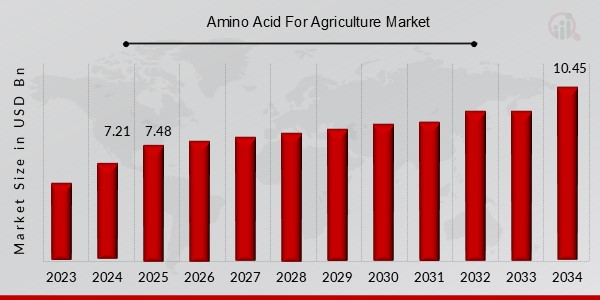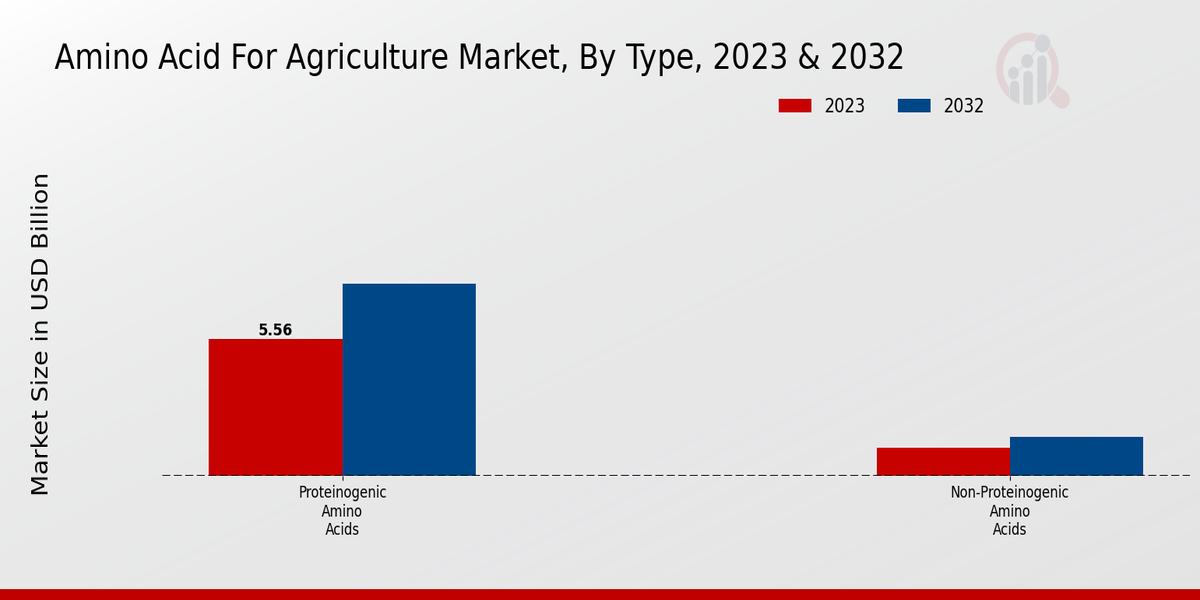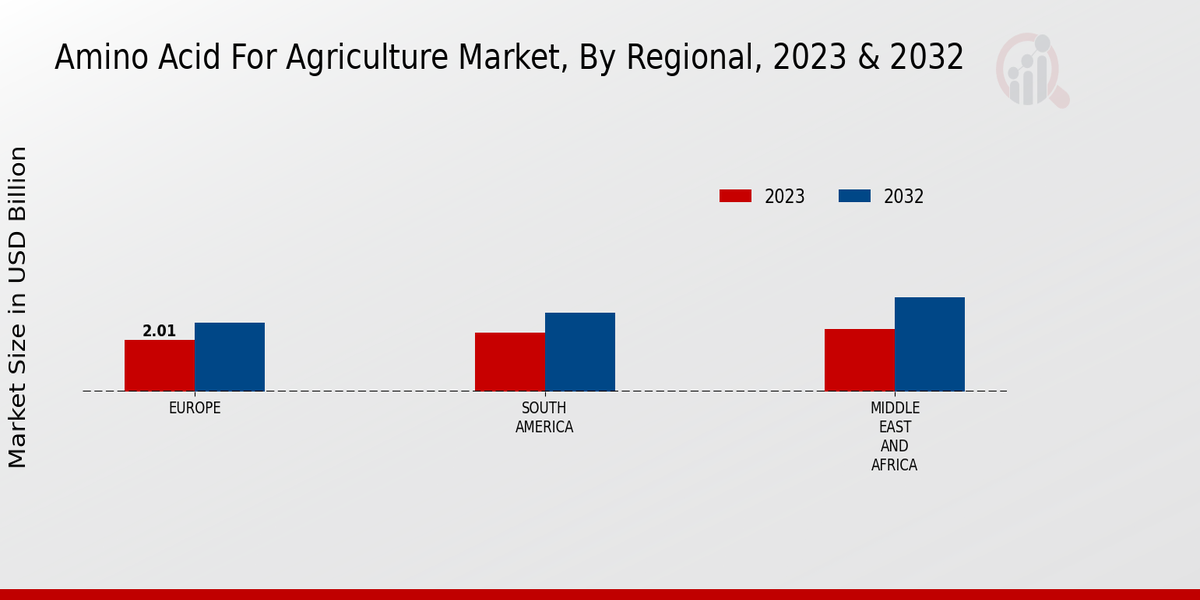Global Amino Acid For Agriculture Market Overview
The Amino Acid For Agriculture Market Size was estimated at 7.21 (USD Billion) in 2024. The Amino Acid For Agriculture Industry is expected to grow from 7.48 (USD Billion) in 2025 to 10.45 (USD Billion) by 2034. The Amino Acid For Agriculture Market CAGR (growth rate) is expected to be around 3.8% during the forecast period (2025 - 2034).
Key Amino Acid For Agriculture Market Trends Highlighted
The agriculture sector in terms of global amino acid usage is estimated to continue growing as there is a rise in the demand for efficient and sustainable approaches to crop production. One of the primary market drivers is the rising consumer awareness of the advantages offered by amino acids in terms of plant health and yield. Countries throughout the world are enacting regulation that seeks to encourage the use of sustainable farming models and this is likely to increase the growth of the market for amino acid-based fertilizers and crop protection products.
The amino acid for agriculture market opportunities is associated with the production of advanced products suited for certain crops and or soil conditions. There has been a developing trend towards designing amino acid formulations that are effective, but also have targeting mechanisms. This combination of amino acid application with precision farming technologies holds promise of better crop nutrition delivery with less environmental pollution risks.
The recent developments which have been observed in the amino acids for agriculture industry include the increased use of foliar application; a nutrient supplying technique which targets plant leaves. The application of the amino acids together with other inputs, for instance the bio stimulants and pesticides is also developing because it brings benefits of crop resistance and yield improvement.

Source: Primary Research, Secondary Research, MRFR Database and Analyst Review
Amino Acid For Agriculture Market Drivers
Increasing Demand for Sustainable Agriculture
As the population and food requirements increase, more stress has been placed on various agricultural resources. For agriculture, Amino Acids help address the issues associated with organic farming where the productivity of crops is increased and the adverse effects on the environment are reduced. Since the amino acids are necessary for the plant along with the plant being a growing organism, their application brings about beneficial tasks like better soil and water management practices.
It is also worth noting that amino acids improve the ability to gather more resistance towards insects and diseases, hence minimizing the number of pesticides and herbicides used. With regard to both of the above described as well as other adoptions, such also leads to favorable outcomes in agriculture, i.e. increased crop yield due to less dependence on synthetic fertilizers.
Growing Adoption of Precision Farming Techniques
Precision farming is an aspect of farming where technology is used to make the crop production as well as the environmental impact of the production optimal. Amino acids for agriculture are one of the components of precision agriculture because they can be used to ensure that nutrient application is tailored to the needs of each crop. This is achieved by soil and plant tissue testing to determine how much amino acid a particular crop may require over a growth period, then provided in the required amount and time, to achieve and maximize yields.The increasing rate at which precision farming is being adopted is one of the factors, which would drive the growth of the Amino Acid For Agriculture Market Industry in the coming years.
Rising Awareness of the Benefits of Amino Acids
Amino acids have increasingly become popular in the agricultural industry, owing to the numerous advantages that have been unveiled by research. It is evidenced that with time, farmers have become better informed about the benefits of amino acids, making the growth of the market an inevitable trend for the amino acid for agriculture market industry. Consequently, industries with amino acids for farming will benefit from the increased awareness among farmers.
Amino Acid For Agriculture Market Segment Insights:
Amino Acid For Agriculture Market Type Insights
The Amino Acid For Agriculture Market is segmented by Type into Proteinogenic Amino Acids and Non-Proteinogenic Amino Acids. Proteinogenic Amino Acids accounted for the largest share of the market in 2023, and this trend is expected to continue through 2032. The growth of this segment can be attributed to the increasing demand for protein in the agriculture industry. Proteinogenic Amino Acids are essential for plant growth and development, and they play a vital role in protein synthesis. The rising demand for food and feed is expected to drive the growth of the Proteinogenic Amino Acids segment.Non-Proteinogenic Amino Acids are not essential for plant growth, but they can provide additional benefits. These amino acids can help to improve plant resistance to stress, and they can also promote plant growth. The growth of the market is being driven by the increasing demand for food and feed, as well as the rising awareness of the benefits of Amino Acids.

Source: Primary Research, Secondary Research, MRFR Database and Analyst Review
Amino Acid For Agriculture Market Application Insights
Feed is the largest application segment of the Amino Acid For Agriculture Market, accounting for over 50% of the market revenue in 2023. The demand for amino acids is primarily due to the growing global population and the increasing consumption of meat and dairy products. Plant nutrition is the second-largest application segment, with a market share of over 25%. Amino acids are the building blocks of plants, and they are used in fertilizers to improve crop yields. Biofertilizers and soil amendment are smaller application segments, but they are growing at a rapid pace due to the increasing demand for sustainable agriculture practices.
Amino Acid For Agriculture Market Source Insights
Fermentation, hydrolysis, and chemical synthesis are the three primary sources for producing amino acids for agricultural applications. Fermentation, a microbial process, is the dominant source, accounting for over 60% of the Amino Acid For Agriculture Market revenue in 2023. It offers advantages such as high yield, cost-effectiveness, and the ability to produce a wide range of amino acids. Hydrolysis, involving the breakdown of proteins into amino acids, holds a significant market share, particularly in the production of specific amino acids like glycine and glutamic acid.Chemical synthesis, though less prevalent, provides an alternative route for producing certain amino acids with specific properties. The Amino Acid For Agriculture Market is expected to witness steady growth in the coming years, driven by rising demand for amino acids in animal feed, fertilizers, and other agricultural applications. Market segmentation allows for a deeper understanding of the industry, enabling stakeholders to target specific market segments and develop tailored strategies for growth.
Amino Acid For Agriculture Market Crop Type Insights
The Crop Type segment is a crucial aspect of the Amino Acid For Agriculture Market, influencing market growth and segmentation. Cereals, legumes, oilseeds, fruits, and vegetables are the key crop types driving market dynamics. Cereals held the largest market share in 2023, and this trend is projected to continue throughout the forecast period. The increasing demand for cereal-based products, such as bread, pasta, and noodles, is a primary factor contributing to this dominance. Legumes, known for their high protein content, are anticipated to witness steady growth due to the rising demand for plant-based protein sources.Oilseeds, utilized for oil extraction and protein meal production, are expected to contribute significantly to market revenue. Fruits and vegetables, rich in essential amino acids, are gaining traction as consumers become more health-conscious. Overall, the Crop Type segment offers immense opportunities for market participants, with each crop type contributing to the industry's growth and shaping its competitive landscape.
Amino Acid For Agriculture Market Formulation Insights
The Amino Acid For Agriculture Market is segmented by Formulation into Liquid, Solid, and Granulated. The Liquid segment held the largest market share in 2023, accounting for around 40% of the Amino Acid For Agriculture Market revenue. The demand for liquid amino acids is increasing due to their ease of application and higher bioavailability compared to other formulations. The Solid segment is projected to grow at the highest CAGR during the forecast period, owing to its longer shelf life and stability. Solid amino acids are preferred for use in animal feed and fertilizers, where they can be stored for extended periods without losing their potency.The Granulated segment is expected to witness moderate growth over the forecast period. Granulated amino acids are gaining popularity due to their ease of handling and reduced dust generation compared to powdered formulations. They are commonly used in foliar sprays and fertigation systems. Overall, the market for Amino Acid For Agriculture is expected to grow at a steady pace over the coming years, driven by increasing demand for sustainable and efficient agricultural practices. The growing awareness of the benefits of amino acids in crop production and animal nutrition is expected to fuel the growth of this market.
Amino Acid For Agriculture Market Regional Insights
The regional segment of the Amino Acid For Agriculture Market offers valuable insights into the geographical distribution of market growth and opportunities. North America is anticipated to continue its dominance in the market, accounting for a significant share of the Amino Acid For Agriculture Market revenue in 2024 and beyond. The region's well-established agricultural industry, advanced farming practices, and increasing awareness of amino acid benefits contribute to its leading position. Europe is projected to follow North America as the second-largest regional market, driven by government initiatives promoting sustainable agriculture and a growing demand for high-quality food products.The APAC region, particularly China and India, is expected to witness substantial market growth due to the rapidly expanding livestock and poultry sectors and the increasing adoption of amino acids in animal feed formulations. South America and MEA are emerging markets with untapped potential, offering significant growth opportunities for amino acid manufacturers and suppliers.

Source: Primary Research, Secondary Research, MRFR Database and Analyst Review
Amino Acid For Agriculture Market Key Players And Competitive Insights:
Major players in Amino Acid For Agriculture Market industry are constantly seeking to expand their market share through mergers, acquisitions, and strategic collaborations. Leading Amino Acid For Agriculture Market players are also investing in research and development to innovate new products and technologies. The Amino Acid For Agriculture Market is expected to witness significant growth in the coming years, owing to the increasing demand for amino acids in animal feed and fertilizer applications. The competitive landscape of the Amino Acid For Agriculture Market is fragmented, with a large number of players operating in the market. However, the market is dominated by a few key players, such as Evonik Industries, Ajinomoto, and Archer Daniels Midland Company. These players have a strong global presence and offer a wide range of amino acids for various applications.Evonik Industries is a leading global supplier of amino acids for animal nutrition. The company has a strong presence in the Asia-Pacific region, where it operates several production facilities. Evonik Industries offers a wide range of amino acids, including lysine, methionine, and threonine. The company is also a major supplier of amino acids for fertilizer applications. Ajinomoto is a leading global supplier of amino acids for food and beverage applications. The company has a strong presence in the Asia-Pacific region, where it operates several production facilities. Ajinomoto offers a wide range of amino acids, including lysine, glutamic acid, and aspartic acid. The company is also a major supplier of amino acids for animal feed applications. Archer Daniels Midland Company (ADM) is a leading global supplier of agricultural commodities and ingredients. The company has a strong presence in the Americas, where it operates several production facilities. ADM offers a wide range of amino acids, including lysine, methionine, and threonine. The company is also a major supplier of amino acids for animal feed applications.Cargill is a leading global supplier of agricultural commodities and ingredients. The company has a strong presence in the Americas, where it operates several production facilities. Cargill offers a wide range of amino acids, including lysine, methionine, and threonine. The company is also a major supplier of amino acids for animal feed applications. Chemoxy International is a leading global supplier of amino acids for animal nutrition. The company has a strong presence in the Asia-Pacific region, where it operates several production facilities. Chemoxy International offers a wide range of amino acids, including lysine, methionine, and threonine. The company is also a major supplier of amino acids for fertilizer applications.
Key Companies in the Amino Acid For Agriculture Market Include:
- Meihua Holdings Group
- DSM
- Jubilant Ingrevia
- ICHI
- Adisseo
- AJINOMOTO
- Cargill
- Evonik
- Shandong Longda Agro
- SK chemicals
-
- Novus International
- CheilJedang
- Thrive Pet Health
- BASF
Amino Acid For Agriculture Market Industry Developments
Rising demand for amino acids in animal feed, increasing awareness about the importance of amino acids in crop production, and growing adoption of precision farming practices are driving market growth. Key industry developments in recent years include the launch of novel amino acid products tailored for specific crop and livestock needs, strategic collaborations between market players to expand product portfolios, and government initiatives promoting sustainable agriculture practices.
Amino Acid For Agriculture Market Segmentation Insights
- Amino Acid For Agriculture Market Type Outlook
- Proteinogenic Amino Acids
- Non-Proteinogenic Amino Acids
- Amino Acid For Agriculture Market Application Outlook
- Animal Feed
- Plant Nutrition
- Biofertilizers
- Soil Amendments
- Amino Acid For Agriculture Market Source Outlook
- Fermentation
- Hydrolysis
- Chemical Synthesis
- Amino Acid For Agriculture Market Crop Type Outlook
- Cereals
- Legumes
- Oilseeds
- Fruits
- Vegetables
- Amino Acid For Agriculture Market Formulation Outlook
- Amino Acid For Agriculture Market Regional Outlook
- North America
- Europe
- South America
- Asia Pacific
- Middle East and Africa
| Report Attribute/Metric |
Details |
| Market Size 2024 |
7.21(USD Billion) |
| Market Size 2025 |
7.48(USD Billion) |
| Market Size 2034 |
10.45(USD Billion) |
| Compound Annual Growth Rate (CAGR) |
3.8% (2025 - 2034) |
| Report Coverage |
Revenue Forecast, Competitive Landscape, Growth Factors, and Trends |
| Base Year |
2024 |
| Market Forecast Period |
2025 - 2034 |
| Historical Data |
2020 - 2024 |
| Market Forecast Units |
USD Billion |
| Key Companies Profiled |
Meihua Holdings Group, DSM, Jubilant Ingrevia, ICHI, Adisseo, AJINOMOTO, Cargill, Evonik, Shandong Longda Agro, SK chemicals, , Novus International, CheilJedang, Thrive Pet Health, BASF |
| Segments Covered |
Type, Application, Source, Crop Type, Formulation, Regional |
| Key Market Opportunities |
Growing demand for animal protein Rising livestock population Technological advancements in amino acid production Increasing awareness of amino acids in animal nutrition Expansion of organic farming practices |
| Key Market Dynamics |
Rising demand for meat Growing population Technological advancements Increasing consumption of proteinrich foods Government regulations |
| Countries Covered |
North America, Europe, APAC, South America, MEA |
Frequently Asked Questions (FAQ) :
The Amino Acid For Agriculture Market is projected to reach 7.21 USD Billion in 2024.
The Amino Acid For Agriculture Market is projected to grow at a CAGR of 3.8% from 2025 to 2034.
North America region is expected to hold the largest market share in the Amino Acid For Agriculture Market in 2034.
The animal feed segment is expected to account for the largest revenue share in the Amino Acid For Agriculture Market in 2034.
Some of the key competitors in the Amino Acid For Agriculture Market include Ajinomoto, Evonik, and Archer Daniels Midland.
The key factors driving the growth of the Amino Acid For Agriculture Market include increasing demand for animal protein, rising awareness of the benefits of amino acids in animal nutrition, and government regulations supporting the use of amino acids in agriculture.
The challenges facing the Amino Acid For Agriculture Market include fluctuating raw material prices, competition from synthetic amino acids, and regulatory challenges.
The opportunities for growth in the Amino Acid For Agriculture Market include expanding into new markets, developing new products, and forming strategic partnerships.
The key trends in the Amino Acid For Agriculture Market include the increasing use of amino acids in precision feeding, the development of new amino acid-based products, and the growing focus on sustainability.
The future prospects for the Amino Acid For Agriculture Market are positive, with continued growth expected over the next decade.
















